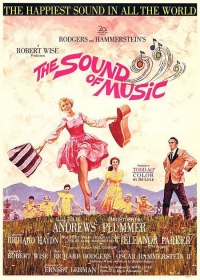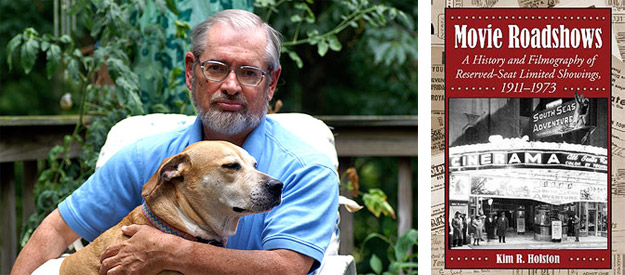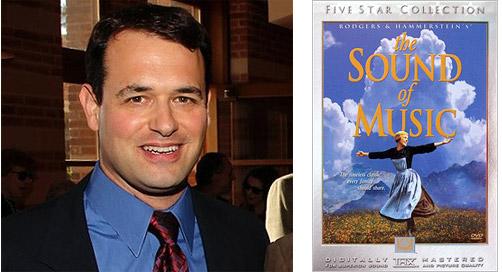“I knew we had a good picture, but I had no idea that it would become such a staggering hit.” — producer-director Robert Wise
“Considering the degree to which most people pride themselves being cynical, I’m still surprised that a movie this heartfelt was so thoroughly embraced by so many people and continues to be. Perhaps folks aren’t as hard-edged as they pretend to be.” — film historian and author Barry Monush [Read more here...]
The Digital Bits is proud to present this retrospective article commemorating the golden anniversary of the release of The Sound of Music, the immensely popular Rodgers & Hammerstein musical motion picture starring Julie Andrews (Mary Poppins, Victor/Victoria) and Christopher Plummer (The Man Who Would Be King, Beginners) and directed by Robert Wise (West Side Story, The Sand Pebbles).
The 50th anniversary tributes and celebrations for The Sound of Music have begun to appear. There is a new Blu-ray Disc and DVD released this week, and earlier this year a new book and special collector’s magazines have been published. Later this month, the award-winning film will be screened at the TCM Classic Film Festival in Los Angeles with stars Julie Andrews and Christopher Plummer in attendance. And it’s now The Bits’ turn and so we celebrate the occasion with this article featuring a detailed listing of the film’s original record-breaking roadshow engagements and an interview with a quartet of film historians who discuss the movie’s significance and enduring appeal.
The Sound of Music, which was based upon the real-life adventures of the singing von Trapp family as well as the German films Die Trapp Familie (1956) and Die Trapp-Familie in Amerika (1958) and the 1959 American stage production, was a true blockbuster (before the term was fashionable) and is noted, among other reasons, for being the first movie to break the box-office performance of Gone With the Wind, the longest tenured box-office champ at 26 years (but still the all-time record holder when accounting for inflation).
Although its overall box-office performance has since been eclipsed by more than 150 films, when adjusted for inflation, however, The Sound of Music rests comfortably at #3 behind Gone With the Wind and Star Wars and still holds many house records for gross and/or duration of engagement. (Prepare to have your mind blown when analyzing the engagement duration data in the roadshow list!) Whether you adore or loathe The Sound of Music, there’s no question the film was an unqualified success, the likes the industry had never seen and one that foreshadowed the blockbuster era.
So, without further ado….
PART 1: THE INTERVIEW
This segment of the article features an interview with film historians Kim Holston, Matthew Kennedy, Mike Matessino, and Barry Monush. The interviews were conducted separately and have been edited into a roundtable format.
Kim Holston is the author of Movie Roadshows: A History and Filmography of Reserved-Seat Limited Showings, 1911-1973 (McFarland, 2013). Kim is a part-time librarian in the Multimedia Department of Chester County Library (Exton, PA) and lives in Wilmington, DE, with his wife Nancy and a menagerie of pets. In addition to Movie Roadshows, he is the author of various film and performing arts books, including Starlet (McFarland, 1988), Richard Widmark: A Bio-Bibliography (Greenwood Press, 1990), Susan Hayward: Her Films and Life (McFarland, 2002), and (with Warren Hope) The Shakespeare Controversy (McFarland, 2nd ed., 2009), and recently Attila’s Sorceress (New Libri Press, 2014) and Naval Gazing: How Revealed Bellybuttons of the 1960s Signaled the End of Movie Cliches Involving Negligees, Men’s Hats and Freshwater Swim Scenes (BearManor Media, 2014). He is presently at work with Tom Winchester on a follow-up to their 1997 book, Science Fiction, Fantasy and Horror Film Sequels, Series and Remakes.
Matthew Kennedy is the author of Roadshow! The Fall of Film Musicals in the 1960s (Oxford University Press, 2014). He is a writer, film historian, and anthropologist living in San Francisco. He has written several other books, including Marie Dressler: A Biography (McFarland, 1999, paperback 2006), Edmund Goulding’s Dark Victory: Hollywood’s Genius Bad Boy (University of Wisconsin Press, 2004), and Joan Blondell: A Life between Takes (University Press of Mississippi, 2007). He is film and book critic for the respected Bright Lights Film Journal and currently teaches anthropology and film history at the City College of San Francisco and San Francisco Conservatory of Music.
Mike Matessino produced and directed the documentary The Sound of Music: From Fact to Phenomenon along with a wealth of archival material for some home-video releases of The Sound of Music. Additionally he worked on the restoration of the music recordings and has written liner notes to accompany the soundtrack release. As part of his work with producer/director Robert Wise he served as Restoration Supervisor for The Director’s Edition of Star Trek: The Motion Picture. In 2012 he produced, with Bruce Botnick, for La-La Land Records a 3-CD expanded score release of Jerry Goldsmith’s music for that film. His other soundtrack credits as producer, mixer, mastering engineer or liner notes writer include The Day the Earth Stood Still, The Sand Pebbles, Empire of the Sun, 1941, Poltergeist, Alien, Gremlins, The Goonies, Back to the Future, Home Alone, Superman, and the Star Wars Trilogy. He also has directed behind-the-scenes documentaries on Alien, John Carpenter’s The Thing, and The Last Starfighter.
Barry Monush is the author of The Sound of Music FAQ: All That’s Left to Know about Maria, the von Trapps, and Our Favorite Things (Applause, 2015). He is also the author of The Encyclopedia of Hollywood Film Actors: From the Silent Era to 1965 (Applause, 2003), Everybody’s Talkin’: The Top Films of 1965-1969 (Applause, 2009) and Music on Film: West Side Story (Limelight, 2010). He updated Stanley Green’s Hollywood Musicals: Year by Year (Applause, 2010) and co-authored (with James Shreridan) Lucille Ball FAQ: Everything Left to Know about America’s Favorite Redhead (Applause, 2011). He joined the staff of Screen World in 1988, eventually becoming the editor of the annual publication. A lifelong film enthusiast, Monush is a researcher at the Paley Center for Media in New York City. He lives in Metuchen, New Jersey. Sunset Blvd. is his favorite movie.
----
Michael Coate (The Digital Bits): In what way is The Sound of Music worthy of celebration on its 50th anniversary?
Kim Holston: The Sound of Music was a phenomenon, and an unexpected one. Who would have thought this musical would overtake Gone With the Wind (in 1965 dollars) to become the top grossing film of all time?
Matthew Kennedy: Perhaps the question should be “In what way is The Sound of Music NOT worthy of celebration”? It’s become a fundamental part of our movie pop culture, right there with The Wizard of Oz, Gone With the Wind, Jaws, E.T. and Star Wars. This feels like celebrating the 50th anniversary of everybody’s favorite aunt.
Mike Matessino: That’s like asking why we should celebrate Independence Day! The Sound of Music is a movie phenomenon that is only truly equaled by Gone With the Wind and the original Star Wars. It cemented the Rodgers and Hammerstein legacy and 20th Century Fox wouldn’t exist today if it were not for that movie. But more importantly it is a movie that reached and touched people on a very deep level and is truly timeless. That’s the whole reason why we celebrate anniversaries, I think, because some things are timeless.
Barry Monush: There are very few works that have endured so completely, well-beyond the era in which they debuted, as The Sound of Music has. It is an instantly recognizable touchstone for not only those of us who first experienced it in the 1960s, but for subsequent generations, and that sort of impact cannot be underestimated. While researching my book I was very pleased to see how many people were quick to share fond memories of seeing it at some point in their lives.

Coate: How is The Sound of Music significant within the musical genre?
Holston: It was the apotheosis of the roadshow musical: lengthy because of the plethora of songs, all of which are memorable, Julie Andrews at the top of her game and already beloved for Mary Poppins.
Kennedy: The Sound of Music had its musical origins on Broadway. It’s not an original screen musical as is The Wizard of Oz, Meet Me in St. Louis, Gigi, and Mary Poppins. That said, it’s just about the smartest adaptation from stage to screen ever made. A few of the songs (My Favorite Things, The Lonely Goatherd) were shuffled to strengthen their meaning within the story, the casting proved to be ideal, the budget was lavish, and, most wisely, it was shot on location in Salzburg and the Austrian Alps. Musically, it’s quite strong, though many claim its score is inferior to other Rodgers and Hammerstein work, including Oklahoma!, Carousel, and South Pacific. That may be, but as a film The Sound of Music is light years beyond the others, largely due to the excellent decisions made in pre-production.
Matessino: Within the film musical genre, The Sound of Music is deceptive in just how significant it is. Consider the Do-Re-Mi sequence. I last screened the movie with a colleague who hadn’t seen it in a while, and he basically said that with that sequence Robert Wise invented the music video. And he’s right. The way that sequence shows the passage of time and changes location was simply not done prior to that. Bob worked all of that out with Ernie Lehman, Saul Chaplin, Maurice Zuberano and the choreographers, Marc Breaux and Dee Dee Wood, and it was a groundbreaking idea. As an aside, Bob also did something very clever with it. When cast and crew returned from Austria over the July 4th weekend in 1964, there was a short break before they resumed filming at Fox. Before they started, Bob screened the edited Do-Re-Mi and you can imagine how that revitalized everyone to complete the picture… because they all now had a unified vision of what it was going to be. And look how some other songs in the movie are handled. First of all, music is itself a character in the story and a lot of the songs are actually occurring as part of the narrative. This was tremendously helpful in getting past the potential jarring moment in musicals where someone starts singing out of nowhere. Ernie Lehman crafted the dialogue very carefully when songs start, and most often, including Do-Re-Mi, Edelweiss and So Long, Farewell, the characters actually “announce” that a song is about to happen. And for other songs the settings were chosen so that the singing seemed acceptable, the lush romantic setting of the gazebo, for example. Climb Ev’ry Mountain and Maria are done within the confines of an abbey. Notice also how the added song I Have Confidence was handled: it begins with Maria in shadow, establishing that this is a self-reflexive moment and really all happening in her mind, much like Over the Rainbow in The Wizard of Oz. And as for the title song, the photography of the opening scene is so majestic, and the helicopter shot that introduces Julie so powerful that someone bursting into song seems the most natural thing in the world. The Sound of Music is a movie musical that truly works, and mainly because the package is clearly marked: it’s about MUSIC and its power to move people and change lives.
Monush: The Sound of Music is the blueprint for how to take a work that was enjoyed on the stage but always considered flawed and improve it to the degree that even those who hold live theater sacred above movie adaptations think of this version as the more significant one. It also contains one of the great scores by two of the most important names in songwriting history, Richard Rodgers and Oscar Hammerstein II. In the musical genre, it is held in high esteem for the effortless manner in which it blends songs and story.
Coate: When did you first see The Sound of Music and what was your reaction?
Holston: I saw The Sound of Music with my mother in July of 1965 at the Midtown Theater in Philadelphia. I was 17 and really didn’t know what to expect, but when the curtains parted and the music began and the camera zoomed in on that hillside I just knew it was going to be great. A sidenote: 20th Century Fox sued the William Goldman theater chain to keep it from ending Sound of Music’s run there on November 15th (1966). It had begun at the Midtown on March 17th, 1965, and the studio wanted to keep it there through the ‘66 holidays. It was still making over $8,000 a week.
Kennedy: I don’t have a clear memory of the first time I saw The Sound of Music. I was very young. I had the LP, and memorized it. I remember seeing a revival of it in a theater in the early 1970s. That was such magnificent cornball bliss! I had a happy childhood, but, oh, I wanted to be a von Trapp Singer!
Matessino: The Sound of Music was my mother’s favorite movie and she took me to see it when I was very young when it played as a revival at a local theater. Like every other kid I was charmed by the songs and the scenery and I was very fortunate to have gotten the big-screen impact of it on my first viewing. Not long after that it played on network TV for the first time and then there were several years of tuning in for the annual airing.
Monush: I saw the film during its reserved-seat engagement at the Paramount Theater in Asbury Park, New Jersey, in October of 1965. The movie held my attention from start to finish, which was quite impressive considering it was three hours long and I was all of six years old. I could recall select images, scenes and musical sequences quite vividly for years after the fact. Since I was seeing this with very little information before going into the theater, I got to witness the famous opening scene for the very first time, up there on the big screen, with no previous point of reference and I remember it being genuinely awesome. Although I was too young to understand the full details behind the terror of the Nazis, I remember being tremendously moved by the image of the family escaping over the mountains at the finale.

Coate: Why do you think The Sound of Music was so incredibly popular?
Holston: It was popular because it was made by and starred professionals. It had the music, it had real-life drama, and it had Richard Haydn’s witty repartee.
Kennedy: Ah, the billion dollar question. The clichéd answer is “children, Nazis, and nuns,” but nobody really knows. This was demonstrated in the years immediately following The Sound of Music, when a succession of would-be Sound of Musics nearly bankrupted their studios with tepid box-office and/or catastrophic cost overruns. That would be Camelot, Doctor Dolittle, Star!, Goodbye, Mr. Chips, Hello, Dolly!, Paint Your Wagon, Sweet Charity, Darling Lili, and others. Nothing captured the singular magical combination of story, song, cast, and timing of The Sound of Music.
Matessino: The popularity of The Sound of Music, apart from the undeniable quality of the filmmaking, has to do with the fact that it addressed three themes that every human being deals with… one, the relationship between parents and children… two, finding your purpose in life… three, standing by your principles. The Sound of Music is a story (and basically a true one) in which a family has to deal with all three of these. It breaks down the barriers and compels an audience to look within and realize that these are the important things in life. As it happens in an almost fairy tale-like setting, there is an archetypal, almost mythical resonance to it. It transcends all cultural and language barriers and no matter how the story is told it retains its power and it will forever.
Monush: This is the question on which all of us can only speculate. Considering the degree to which most people pride themselves being cynical, I’m still surprised that a movie this heartfelt was so thoroughly embraced by so many people and continues to be. Perhaps folks aren’t as hard-edged as they pretend to be. For me, it’s simply a tremendous piece of filmmaking, thanks to the skills of director Robert Wise, writer Ernest Lehman, and the rest of the company working at the top of their game. Julie Andrews’ contribution cannot be underestimated because what could have been merely a good movie became something very special indeed due to her participation. It’s a triumphant story that makes you care about what happens to its characters, and leaves you with the feeling that what you have just seen has been both enormously entertaining and emotionally satisfying. Perhaps that’s what does the trick.
Coate: Where does The Sound of Music rank among star Julie Andrews’ body of work?
Holston: In Julie Andrews’ oeuvre, it is equal and maybe surpasses Mary Poppins. It might be a matter of taste. Poppins was set-bound, Sound of Music was filmed mostly in the great outdoors.








